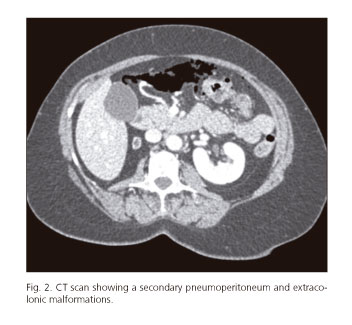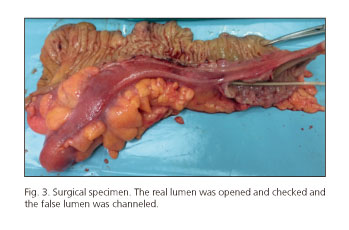Mi SciELO
Servicios Personalizados
Revista
Articulo
Indicadores
-
 Citado por SciELO
Citado por SciELO -
 Accesos
Accesos
Links relacionados
-
 Citado por Google
Citado por Google -
 Similares en
SciELO
Similares en
SciELO -
 Similares en Google
Similares en Google
Compartir
Revista Española de Enfermedades Digestivas
versión impresa ISSN 1130-0108
Rev. esp. enferm. dig. vol.109 no.12 Madrid dic. 2017
https://dx.doi.org/10.17235/reed.2017.4784/2017
PICTURES IN DIGESTIVE PATHOLOGY
Complete tubular colonic duplication in an adult: a rare incidental finding and the risk of colonoscopic perforation
Irene López-Rojo, Marta González-Bocanegra, Patricia Tejedor and Carlos Pastor
Division of Colorectal Surgery. Department of General Surgery. Hospital Universitario Fundación Jiménez Díaz. Madrid, Spain
Case report
A colonoscopy was performed in a 55-year-old woman under investigation for anemia and an incidental complete double-barreled colonic duplication (CD) was identified. The real colonic lumen had a communication track with the false lumen arising from the rectum throughout the colonic length, ending as a "cul-de-sac" at the caecum (Fig. 1).
A colonic perforation was suspected during the endoscopy. A computed tomography (CT) scan was performed that identified a secondary pneumoperitoneum as well as the following findings: a Meckel's diverticulum, right renal agenesis, bicornuate uterus and lumbosacral transitional vertebrae (Fig. 2). A right colectomy was required due to a traumatic perforation at the colonic hepatic flexure, affecting both duplicated lumens (Fig. 3).
Discussion
CD is infrequent (6% of gastrointestinal duplications) and commonly associated with genitourinary or vertebral malformations (1). Diagnosis in adults is rare and could present when an acute complication occurs (2). CD does not usually require surgery except in symptomatic or complicated cases (3). Endoscopy surveillance should be performed due to an uncommon but well documented risk of malignancy. When CD is being investigated, extra care should be taken during the endoscopy due to the high risk of perforation.
Conclusions
Incidental diagnoses of colonic duplications are rare in adults. However, they should be considered in the setting of acute abdominal complications. Surgery must be reserved for symptomatic or complicated cases.
References
1. Shah KR, Joshi A. Complete genitourinary and colonic duplication. A rare presentation in an adult patient. J Ultrasound Med 2006;25:407-4113C. [ Links ]
2. Roohollah S, Mohammad JF, Niloufar AY, et al. Tubular duplication of the sigmoid colon with acute abdomen: An adult case report. Indian J. Surg 2015;77(Suppl 3):S1005-7. [ Links ]
3. Seshadri AJ, Bleday R. Colonic duplication. Am Surg 2015;81(3):E99-101. [ Links ]
















